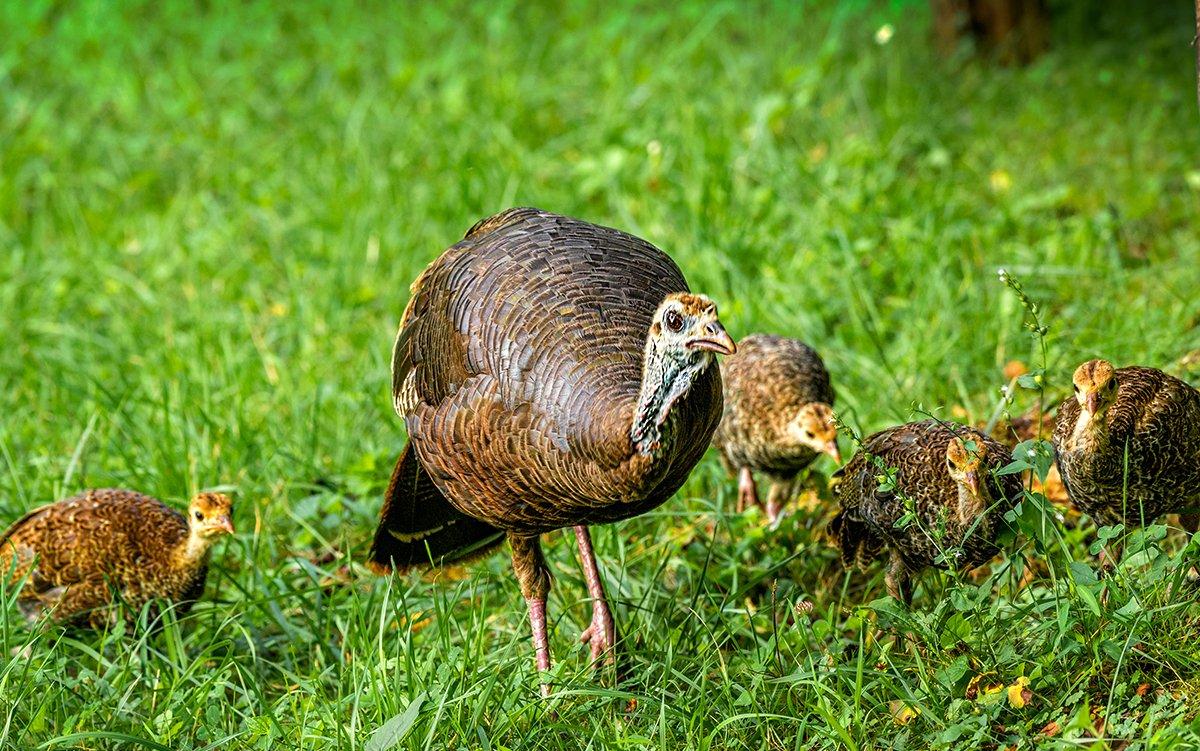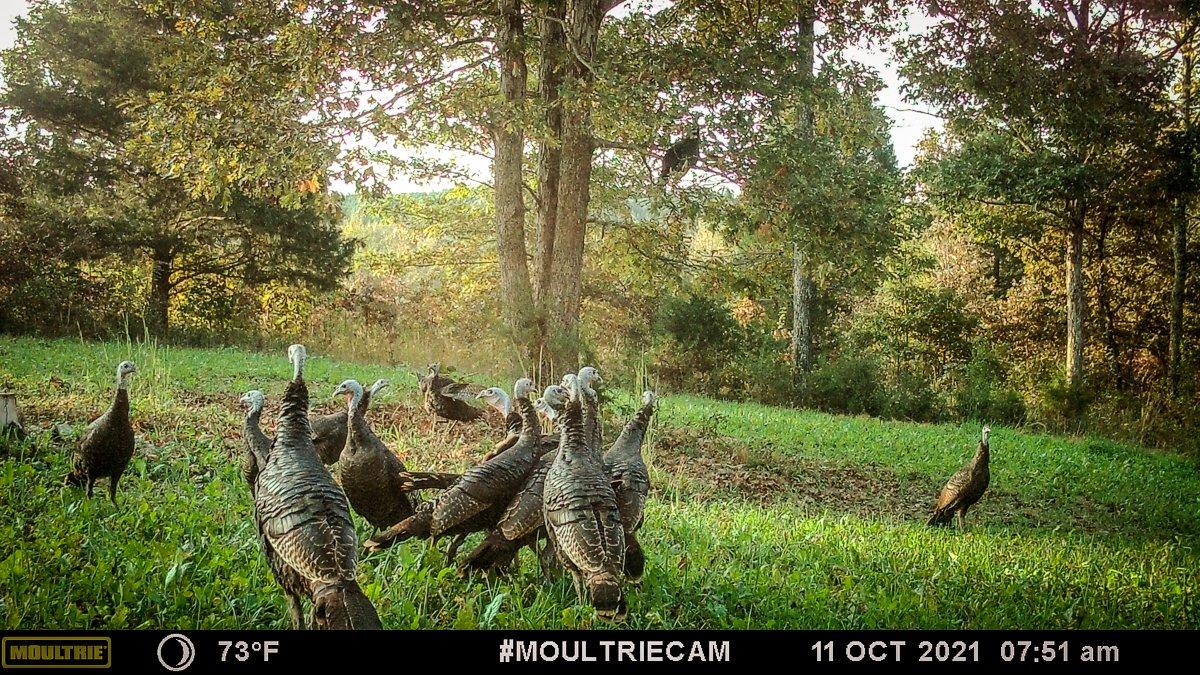Is it predators? Loss of habitat? Disease? The weather? Three top biologists weigh in on the uphill battle facing little turkeys every summer
Of the many challenges facing wild turkeys right now in parts of the country, there are a number of things we don't know, but one thing that's unequivocal. There aren't enough poults surviving to increase — and in some cases, even maintain — healthy turkey flocks from year to year.
Studies have shown that to keep a population stable, hens need to produce an average of at least two surviving poults per nesting. More than two and population numbers increase; less than two, and populations fall. In parts of the southern U.S., we are well under two, with some of the hardest hit areas hovering around one or even less, said Mark Hatfield, wildlife biologist and Director of Conservation Services for the National Wild Turkey Federation.
We are most likely looking at a number of factors that are affecting wild turkeys throughout their range. The impact of these factors may vary according to location, said Dr. Michael Chamberlain, Terrell Professor of Wildlife Ecology and Management at the Warnell School of Forestry and Natural Resources at the University of Georgia. It's clear the population in many of the areas we study is getting older on average. Thirty years ago, the vast majority of turkeys we would trap to study would be juvenile birds. Today, fewer than 20% of our trapped birds are juveniles.
There is no question that turkey numbers are down in many areas, the southeastern U.S. being particularly concerning, added Dr. Will Gulsby of the University of Auburn School of Forestry and Wildlife Sciences. Gulsby and Chamberlain are working on a research project funded in part by the Alabama Wildlife Federation and Turkeys for Tomorrow, a Mississippi-based conservation nonprofit organization, of which Realtree is a sponsor.
The project will use autonomous recording units to record and analyze gobbling data from across the state to pinpoint peak breeding seasons. Additional studies will determine the proportion of male turkeys capable of fertilizing clutches of eggs, as well as capturing and fitting hens with GPS tracking devices that will monitor when they nest, the success and failure rates of their nests, the causes of nest failure, and the survival of the young turkeys after they hatch. Researchers will also collect tissue samples for subsequent disease testing. Gulsby hopes his project will shed light on what is causing the declines in turkey populations and offer answers to reverse the trend.
(Want to hear more about these studies? Listen to this podcast.)
In many of the areas we are studying, we are finding nesting success where at least one poult survives is only running around 20 to 25%. If you factor in brood survival at around 33% after hatching, that means that out of 100 turkey nests, only 25 will produce at least one poult and only seven or eight of those poults will survive to fall, Gulsby said.
Habitat Loss
All three biologists pointed to habitat loss as one of the primary factors negatively influencing turkey populations. Gulsby said turkeys are generalists. Their habitat needs change according to the season, he said. What might be good nesting habitat in the spring may not be the best area for successfully raising poults, and that area might not be the same that a turkey needs to survive the winter. Turkeys need all of these areas in a nearby range.
Unfortunately, we are seeing habitat loss at an all-time high. According to a recent U.S. Forest Service study, we are losing about 6,000 acres of open space, including grasslands, farms and forests, per day. The southeastern U.S. has experienced the greatest loss of open space, with over 6 million acres developed between 1982 and 1997 alone. Conversion of CRP land to large-scale farming and home building sites is one issue, along with decreased forest timber management leading to more mature stands of hardwoods and pines, which results in less of the dense understory growth more favorable to nesting and poult rearing.
There are several studies that show a direct correlation between the distance a hen travels with her poults and the mortality rate of those poults, said Chamberlain. The farther a hen has to travel from nesting to feeding areas, or to roosting areas, the higher the rate of predation. Poults that travel a great distance also mature at a slower rate, meaning they molt later and stay on the ground longer, plus go into their first winter with poorer overall body condition.
Perhaps closely tied to habitat changes, Chamberlain also noted that there's been a global decline in insect populations. Wild turkeys, particularly poults, are designed to feed on insects that supply the needed protein that allows them to go into winter in prime condition. Reductions in open grasslands and changes in farming practices, including increased use of pesticides, can have a direct impact on insect populations. Jumps in turkey hatch rates and population growth in years following large cicada hatches illustrates just how important insects can be for turkey production.
Predation
Predators, nest predators in particular, play an undeniable roll in poor poult recruitment, Gulsby said. In some of our studies, predators resulted in the majority of nest failures, in some places as high as 75% of the monitored nests.
(Don't Miss: 5 Trapping Baits Nest-Raiding Raccoons Can't Resist)
But poor habitat also leads to higher predation. When nesting conditions are poor, hens and nests are more exposed. In areas where nesting conditions are limited, nests are concentrated. Say you have the majority of turkey nests concentrated in 10% of the available habitat. That makes it easy for nest predators to key on that area and do substantial damage, Hatfield said.
It's also possible that hunters themselves are partly responsible for increased predation on turkey nests. Increased feeding of deer in some areas has created an artificially high predator population, drawing raccoons, possums, skunks, and wild hogs into concentrated areas.
Disease
Biologists have long been monitoring diseases such as avian pox and West Nile virus in wild turkey populations. Avian pox accounts for nearly one quarter of the diagnoses of sick or dying wild turkeys examined in the Southeast. While fairly common and sometimes fatal, most biologists don't consider it to be a serious, large-scale risk at this time. Nor has West Nile been shown to have a significant impact on turkey mortality (though some research in Pennsylvania has pointed to it as a possible factor in declining eastern ruffed grouse populations, game birds that are closely related to wild turkeys).
A relatively new disease that many biologists are noting is lymphoproliferative disease (LPDV), a type-C retrovirus associated with tumors in a number of organs in domestic turkeys. Dr. Gulsby reports that some studies, including one in North Carolina, have documented LPDV infection rates as high as 50% in tested wild birds. While most cases are asymptomatic and cause no issues in wild birds, Gulsby said that at least one study done in Maine showed the possibility of decreased clutch sizes in wild turkeys infected with LPDV. A large part of our study will consist of disease monitoring in captured birds to see if LPDV or other diseases might be playing a role in decreased populations, Gulsby said.
Disrupted Breeding Patterns
Increasingly, research points to early hunting seasons as a possible factor in disrupted breeding cycles. For years, it was assumed that the bulk of the hens in a given area would breed in a compact window of time fairly early in the spring, go on nest about the same time, and hatch their poults in a similar time frame, Chamberlain said. That's how it should be. Laying and hatching the bulk of the poults together provides high population densities, which reduces the overall impact of predators on the species, known as predator swamping, and it hatches the poults during a time when both food and cover are at their peak.
But modern research shows that breeding and nesting times are becoming increasingly spread out. One theory is that early hunting season dates are allowing the harvest of too many dominant toms before they are able to breed the majority of the hens in an area. With turkeys, breeding order is established early in the spring, well before season. When the dominant tom in an area is removed, the pecking order has to be reestablished before the next tom up resumes breeding activity, possibly causing the breeding dates to be delayed and extended.
(Don't Miss: Is Your Deer Bait Killing Turkeys?)
Several southeastern states have noticed that research and taken action. Alabama and Georgia pushed back opening dates this year to more closely coincide with peak nesting times, well after the bulk of available hens have been bred. Mississippi has limited the number of non-resident hunters on its public lands early in the season.
How Can We Fix It?
The most effective way a turkey hunter can increase local populations is to manage the habitat to maximize its efficiency for turkeys, Gulsby said. Prime turkey habitat is a patchwork of different zones in close proximity to each other.
Think of it as looking like a quilt or a checkerboard from above, Hatfield said. You want lots of diversity across the habitat and very little monoculture, like mature timber stands or open crop fields. Improvements can include planting native grasses to replace fescue fields to increase nesting and brood rearing cover with increased insect loads. Manage timber stands by selectively harvesting mature trees to open the forest floor, increase sunlight, and encourage growth of secondary cover like honeysuckle and blackberry for better cover.
All three biologists were in favor of controlled burns to improve habitat. Instead of one large controlled burn, consider several small blocks of burns spread evenly over the landscape to provide open feeding locations for hens and poults but still be nearby thick cover to escape predator attacks.
Control predator populations by any means available, including trapping and hunting whenever your state allows. Studies done on other ground-nesting birds like quail show that predator control in the weeks leading up to nesting is the most effective time, but any control is better than none. Some states, like Georgia, have explored the possibility of extending or eliminating closed seasons on some nest predators. Introduced in February, H.B. 1147 would eliminate Georgia's closed season for raccoons and opossums, and would allow private landowners to hunt and trap the two species year-round.
Hunters might also consider eliminating or reducing bait sites for deer or other game while turkeys are nesting or near nesting cover to reduce predator loads in those areas.
Support turkey conservation groups like Turkey's for Tomorrow and NWTF so that they can continue to research turkey populations and the possible causes for their declines.
While we can't do much for disease prevention and large-scale habitat loss, we can provide nesting hens and new poults with the best chance of survival through prime habitat on the lands we manage.











